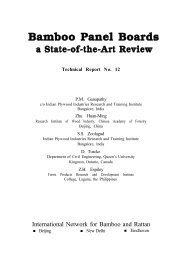The Bamboo and Rattan Sectors in Asia: an Analysis of ... - INBAR
The Bamboo and Rattan Sectors in Asia: an Analysis of ... - INBAR
The Bamboo and Rattan Sectors in Asia: an Analysis of ... - INBAR
Create successful ePaper yourself
Turn your PDF publications into a flip-book with our unique Google optimized e-Paper software.
<strong>The</strong> villagers go to the forest for several days at a time dur<strong>in</strong>g the harvest<strong>in</strong>g<br />
season from J<strong>an</strong>uary through March. This is the dry season when work <strong>in</strong> the forest<br />
is easier, <strong><strong>an</strong>d</strong> it is the le<strong>an</strong> period <strong>in</strong> the agricultural calendar. <strong>The</strong> cutters go <strong>in</strong><br />
family groups <strong><strong>an</strong>d</strong> camp <strong>in</strong> the forest. <strong>The</strong> camp is set up <strong>in</strong> a central area, with<br />
shelters constructed <strong>of</strong> bamboo found at the site. While men go <strong>in</strong> search <strong>of</strong> ratt<strong>an</strong>,<br />
women (<strong><strong>an</strong>d</strong> small children) rema<strong>in</strong> at the camp to prepare food. <strong>The</strong> cutters haul the<br />
ratt<strong>an</strong> to a 'stockyard' at the road head, the furthest po<strong>in</strong>t accessible to the truck that<br />
picks up the ratt<strong>an</strong>. Although theoretically a person c<strong>an</strong> cut up to 100 ratt<strong>an</strong> pieces<br />
<strong>of</strong> 4.6-5.2 m <strong>in</strong> a day, the subsequent haul<strong>in</strong>g <strong><strong>an</strong>d</strong> associated jobs <strong>in</strong>volved limit it to<br />
<strong>an</strong> average <strong>of</strong> about 10 pieces per person per day delivered to the stockyard. <strong>The</strong><br />
average family group collects about 500 to 1 200 pieces per year, though they would<br />
harvest more if there was a dem<strong><strong>an</strong>d</strong> for it. <strong>The</strong> people are a bit wary <strong>of</strong> the labor<br />
<strong>in</strong>volved <strong>in</strong> ratt<strong>an</strong> gather<strong>in</strong>g. One village headm<strong>an</strong> reported that people from his<br />
village had collected ratt<strong>an</strong> last year, but would not do so this year because it was<br />
too far away from the road.<br />
<strong>The</strong> 'traders' <strong>in</strong> the ratt<strong>an</strong> sector are <strong>in</strong> fact 'agents'. <strong>The</strong>y are authorized by the<br />
ratt<strong>an</strong> factories, which hold the legal right to the ratt<strong>an</strong>, to deal with the cutters to<br />
arr<strong>an</strong>ge the collection <strong><strong>an</strong>d</strong> payment. M<strong>an</strong>y <strong>of</strong> these traders are <strong>in</strong>volved <strong>in</strong> other<br />
forest enterprises, especially <strong>in</strong> the tr<strong>an</strong>sportation <strong>of</strong> timber. Thus, they have access<br />
to the villages near forest <strong><strong>an</strong>d</strong> to tr<strong>an</strong>sportation. <strong>Ratt<strong>an</strong></strong> trad<strong>in</strong>g typically makes up<br />
about 20% <strong>of</strong> their <strong>in</strong>come. <strong>The</strong>y ma<strong>in</strong>ta<strong>in</strong> long-term relationships with the factories,<br />
procur<strong>in</strong>g ratt<strong>an</strong> for the same factories over a period <strong>of</strong> years. Only one <strong>of</strong> the traders<br />
<strong>in</strong>terviewed had switched, procur<strong>in</strong>g some ratt<strong>an</strong> for a new factory while at the same<br />
time supply<strong>in</strong>g to the old.<br />
<strong>The</strong> ma<strong>in</strong> job <strong>of</strong> a trader is to org<strong>an</strong>ize the cutters to deliver ratt<strong>an</strong> to <strong>an</strong> agreed<br />
po<strong>in</strong>t with access to the road (or river) to pick up the ratt<strong>an</strong>, <strong><strong>an</strong>d</strong> to deliver the same<br />
to the ratt<strong>an</strong> factory. <strong>The</strong>y <strong>of</strong>ten make adv<strong>an</strong>ce payment, <strong>in</strong> cash or rice, to the<br />
collectors. <strong>The</strong>y compla<strong>in</strong>ed that sometimes they have difficulty gett<strong>in</strong>g the ratt<strong>an</strong><br />
due to them when the collectors opt not to go to the forest or c<strong>an</strong>not f<strong>in</strong>d enough<br />
ratt<strong>an</strong> to pay back the adv<strong>an</strong>ce. This risk is compounded by potential losses from<br />
deterioration <strong><strong>an</strong>d</strong> shr<strong>in</strong>kage <strong>of</strong> ratt<strong>an</strong> susta<strong>in</strong>ed dur<strong>in</strong>g tr<strong>an</strong>sportation. Several traders<br />
reported that furniture m<strong>an</strong>ufacturers sometimes reduce the grade <strong><strong>an</strong>d</strong> pay a lower<br />
price, but they buy all that is brought by the collectors.<br />
<strong>The</strong> traders are responsible for ensur<strong>in</strong>g that the ratt<strong>an</strong> consignments are<br />
<strong>in</strong>spected by the Forest Department. <strong>The</strong>y take the load to a Forest Department <strong>of</strong>fice,<br />
where it is checked <strong><strong>an</strong>d</strong> the tr<strong>an</strong>sport certificate issued aga<strong>in</strong>st the quota. <strong>The</strong> traders<br />
report that they have to produce this document at as m<strong>an</strong>y as 20 checkpo<strong>in</strong>ts. At each<br />
checkpo<strong>in</strong>t they are levied <strong>an</strong> 'un<strong>of</strong>ficial' charge (bribe) <strong>of</strong> around 2 000 - 3 000 kip,<br />
or about 1 kip/c<strong>an</strong>e.<br />
Traders typically deal with 6 or 7 villages <strong>in</strong> a district, with between 15 <strong><strong>an</strong>d</strong> 20<br />
families <strong>in</strong> each village <strong>in</strong>volved <strong>in</strong> ratt<strong>an</strong> collect<strong>in</strong>g. <strong>The</strong>y work with a particular<br />
village for a few years, until the accessible ratt<strong>an</strong> is exhausted, <strong><strong>an</strong>d</strong> then locate a new<br />
42












